|
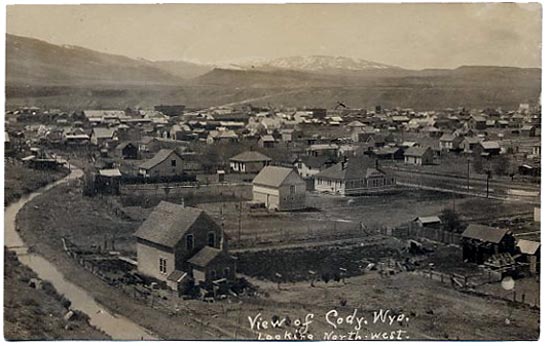
Cody, looking northwest, approx. 1910.
A history of an area is often found in its street names. This is true of Cody. In addition to
Gerrans, Bleistein and Rumsey Avenues, the town's founders, George T. Beck and Horace Alger are commermorated in the
names of streets. Another street is named after the Wild West show's general manager, Nate Salsbury. Although there is an
Ingraham Dr., it was not named after the show's advance agent, Prentise Ingraham (1843-1904). Instead Ingraham Dr. and Newton Ave.
are named after early settlers in Park County. Prentise Ingraham, nevertheless had an important part in the
promotion of the Wild West show as the author of numerous dime novels, including some 200 books in Buffalo Bill series. Among the
Buffalo Bill books were such adventures as, Buffalo Bill and the Nihilists, or, a Dangerous Mission; Buffalo Bill and the
Red Marauders; and Buffalo Bill's Air Voyage. During the course of
his career he penned 600 novels and 400 novelettes. In once instance he wrote a
70,000 word novel in one week, and in another a 35,000 word novel in only 24 hours. As critics have
pointed out, such haste did not permit carefully crafted plots or character development. But Ingraham's
own life was probably more adventurous than the characters he portrayed in the novels.
Ingraham enlisted in Confederate Forces at the age of 18. Following the war, like many a Confederate and
Union veteran, he became a mercenary, serving at various times under President Juarez against the
Emperor Maximillian, in Crete in the war against the Turks, with Cuban revolutionaries against the
Spanish, and in the Army of the Khedive of Egypt. In the officer corps of the Khedive were over
41 officers who had served in either the Union or
Confederate Army, including several who had served in Wyoming. Indeed, in several
instances Gen. Sherman granted leaves of absence so that officers could join the
Khedive. Officers received the same pay as they would have for the same rank in the
American Army. In Cuba, Ingraham was captured by
the Spanish, sentenced to death, and escaped. On August 12, 1904 he checked into the
Confederate Old Soldiers' Home at Beauvoir, Biloxi, Mississippi, and died four days later of Bright's Disease.
Writer's note: Beauvoir was the retirement home of President Jefferson Davis. Today, the
estate is the site of the Tomb of the Unknown and the Davis Presidential Library. President Davis's home, Library and associated
buildings suffered major damage during Hurricane Katrina. The cottage in which he wrote his
epic account of the War The Rise and Fall of the Confederate Government was totally destroyed as was the
barracks and Confederate Veterans' Hospital. Repairs to the house are expected to be completed for a
reopening of the house by June 3, 2008 (Jefferson Davis's Birthday in a number of Southern States). The Presidential Library is anticipated to reopen by
September 2009.
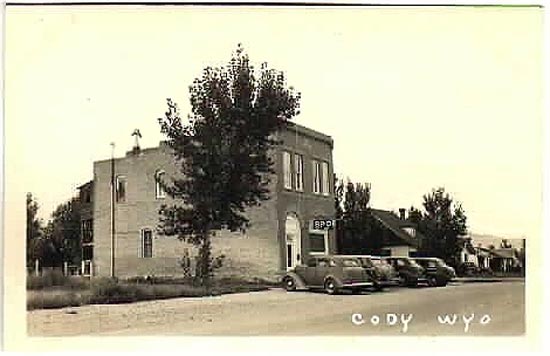
Cody Elks Lodge, approx. 1939.
In addition to the Elks, other early fraternal orders in Cody included the Odd Fellows and the
Masons.
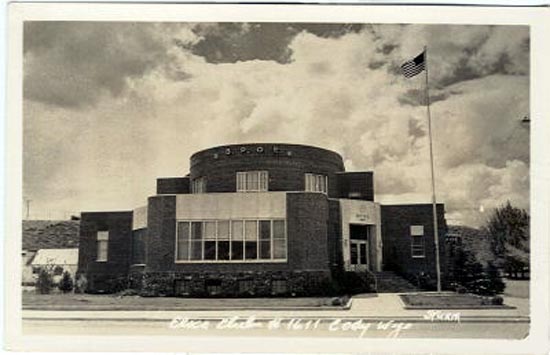
Cody Lodge No. 1611, B. P. O. E., 1950's
The most important community organizations, however, are those devoted to the Buffalo Bill Museum and to the Cody Stampede and the
Cody Nite Rodeo.
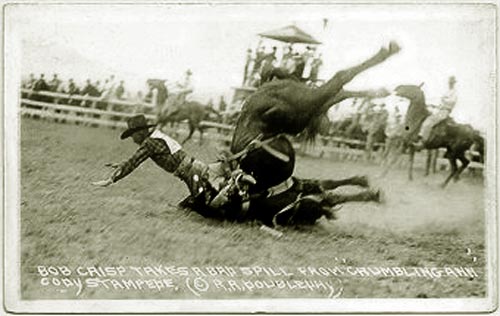
Bob Crisp Coming Off Crumbling Ann, Cody
Stampede, photo by Ralph Doubleday, see text below.
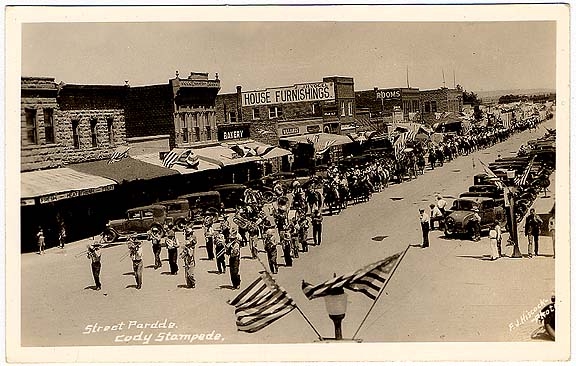
Cody Stampede Parade, approx. 1930, photo by F. J. Hiscock
The Stampede was started in 1918 in an effort to attract tourists to
the area and was timed in June in that year so as to predate the advent of Prohibition.
As indicated by the next photo, there had, of course, been rodeos
before the war. The Stampede's first president was local newspaper woman and novelist Caroline Cameron Lockhart (1871-1962). Miss
Lockhart came to Cody in 1904 after having worked for the Boston Post and the
Philadelphia Bulletin.
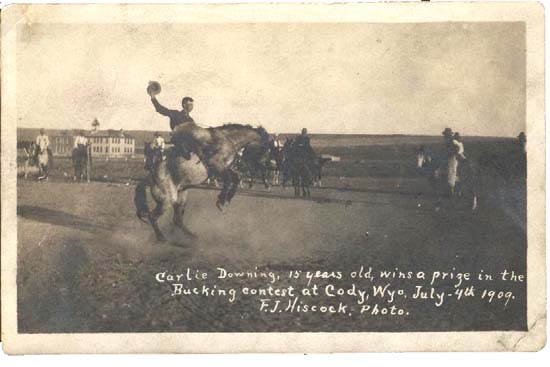
Carl Downing in Bucking Contest, 1909. Photo by F. J. Hiscock.
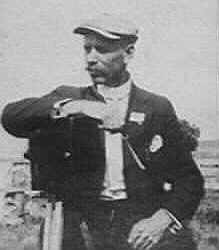 F. J. Hiscock, "The Picture Man," undated
F. J. Hiscock, "The Picture Man," undated
Carl "Carly" Downing later appeared with his older brother Gailord "Gail" Downing in
Col. Cody's Wild West show. Carl Downing was also a founder of the Stampede and helped
organize the Cody Nite Rodeo in 1938. Other members of the Wild West settled in Cody. Among them was
Frank N. Hammitt (1870-1903) who appeared in an early 1894 Edison movie, filmed in Brooklyn when
the Wild West was playing in New York. The film shows another "real" cowboy, Lee Martin, riding his broncho Sunfish while
Hammitt standing on the corral fence fires a gun. Originally Hammitt, Chief of the Cowboys in the show, was also
to ride his horse El Dorado but the little studio did not have room. Hammitt moved to Cody in 1898 and became a ranger in the Yellowstone Forest Reserve. He was killed when he fell
from a cliff in 1903.
Joseph Jesse Faver "Fay Jay" Hiscock (F. J. Hiscock) (1874-1951), many of whose pictures are
featured on these pages, was originally from Kalamazoo, Michigan.
He remained active in photography in Cody from his arrival in 1904 until the early 1940's, and sold
packages of photographs to tourists. The packages were primarily of the Cody
Road. In his advertising he referred to himself as "The Picture Man."
Next Page: Caroline Lockhart.
|